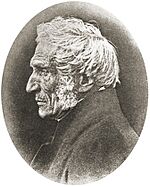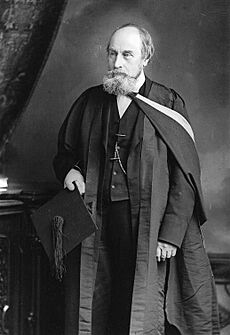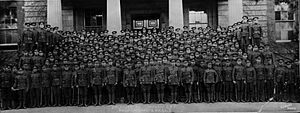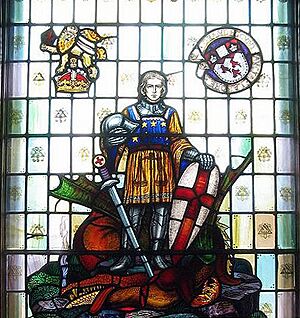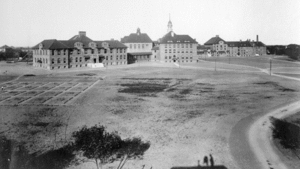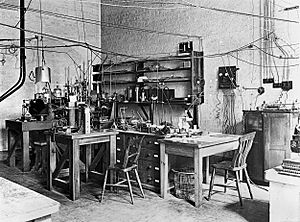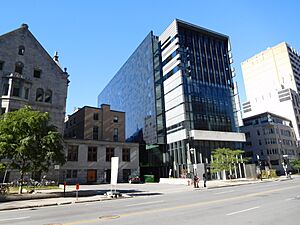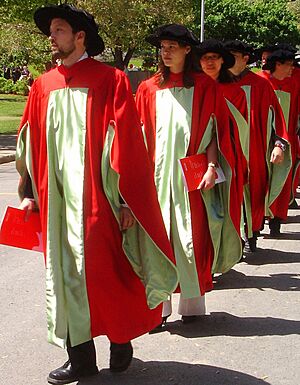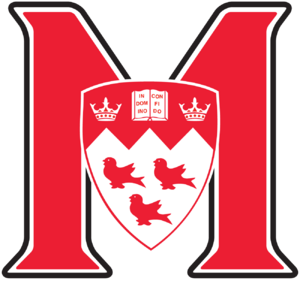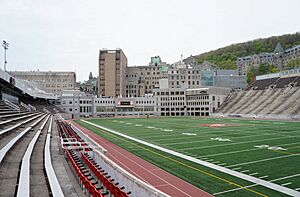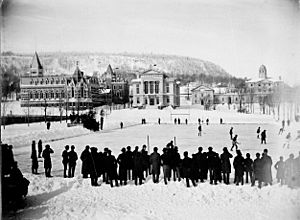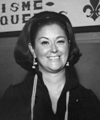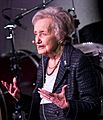McGill University facts for kids
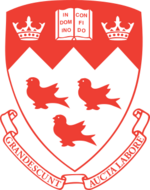
Coat of arms
|
|||
|
Other name
|
Université McGill (French) | ||
|---|---|---|---|
|
Former name
|
McGill College or University of McGill College (1821–1885) | ||
| Motto |
|
||
|
Motto in English
|
|
||
| Type | Public research university | ||
| Established | March 31, 1821 | ||
| Founder | James McGill | ||
|
Academic affiliation
|
AAU, ACU, AUCC, AUF, ATS, CARL, CBIE, BCI, CUSID, GULF, UArctic, UNAI, U15, URA | ||
| Endowment | CA$2.109 billion | ||
| Budget | CA$1.555 billion | ||
| Chair | Maryse Bertrand | ||
| Chancellor | Pierre Boivin | ||
| President | H. Deep Saini | ||
| Visitor | Mary Simon (as Governor General of Canada) | ||
|
Academic staff
|
3,476 (staff) 1,747 tenure track, 1,667 non-tenure track (faculty) | ||
|
Administrative staff
|
4,327 | ||
| Students | 39,513 (2022) | ||
| Undergraduates | 27,085 (2022) | ||
| Postgraduates | 10,344 (2022) | ||
|
Other students
|
2,084 (2022) | ||
| Location |
,
Canada
45°30′15″N 73°34′29″W / 45.50417°N 73.57472°W |
||
| Campus |
|
||
| Language | English | ||
| Newspapers | The McGill Daily The Tribune |
||
| Colours | McGill Red and White
|
||
| Nickname | McGill Redbirds and Martlets | ||
|
Sporting affiliations
|
|
||
| Mascot | Marty the Martlet | ||
 |
|||
McGill University (French: Université McGill) is a large English-speaking public university in Montreal, Quebec, Canada. It was started in 1821 by a special paper from the King. The university is named after James McGill, a Scottish businessman. He left money in 1813 to create the school. In 1885, its name officially became McGill University.
McGill has over 39,000 students. Its main campus is in downtown Montreal, near Mount Royal. There is also a second campus, called Macdonald Campus, in Sainte-Anne-de-Bellevue. This campus is about 30 kilometers west of the main one. McGill is one of the top universities in Canada and North America. It offers more than 300 different study programs. Many students study in areas like Arts, Science, Medicine, Education, Engineering, and Management.
Many famous people have studied or worked at McGill. These include 12 Nobel Prize winners and 3 former prime ministers of Canada. Also, 2 governors general of Canada went to McGill.
Contents
History of McGill University
How McGill University Started
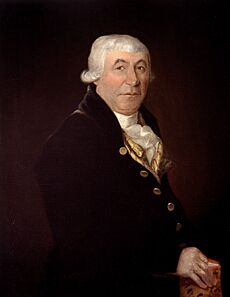
The Royal Institution for the Advancement of Learning (RIAL) was created in 1801. It was set up to start free schools and help learning in the province. RIAL first ran two Royal Grammar Schools in Quebec City and Montreal. This was important for public education. It showed the government wanted to help pay for schools and teachers.
When James McGill passed away in 1813, he left his money to RIAL. In 1846, the Quebec City school closed. The Montreal school joined with the High School of Montreal. By the mid-1800s, RIAL mostly focused on managing McGill's gift. Today, RIAL still exists. It is the official group that runs McGill University and its different parts.
The Beginning of McGill College
James McGill was born in Glasgow, Scotland, in 1744. He became a very successful businessman in Quebec. He studied at the University of Glasgow before coming to North America. He explored business chances, especially in the fur trade.
Between 1811 and 1813, James McGill wrote his will. He left his "Burnside estate," which was a large piece of land, and 10,000 pounds. This money and land went to the Royal Institution for the Advancement of Learning. He wanted them to use it to start a "University or College" for education. The will said the college had to be set up within ten years of his death.
On March 31, 1821, McGill College received a special paper from King George IV. This paper, called a royal charter, allowed the college to be a university and give out degrees. The first leader of McGill College was The Right Reverend George Mountain.
Growing the University Campus
Even though McGill College got its royal charter in 1821, it didn't start teaching right away. In 1829, the Montreal Medical Institution joined McGill. It became the first medical school in Canada. The first medical degree in Canada was given out in 1833.
The Faculty of Medicine was the only part of the school working until 1843. That's when the Faculty of Arts began teaching. They used the new Arts Building. The Faculty of Law started in 1848. It is also the oldest law school in Canada.
Sir John William Dawson was McGill's leader from 1855 to 1893. Many people say he helped turn McGill into a modern university.
Education for Women at McGill
Women started getting an education at McGill in 1884. Donald Smith helped pay for special classes for women. The first degrees for women at McGill were given in 1888. In 1899, the Royal Victoria College (RVC) opened. It was a place for women students to live at McGill. Until the 1970s, all female undergraduate students were part of RVC. Today, part of Royal Victoria College is for both male and female students, but one section is still only for women.
McGill During World War I
Many students and former students joined the army when World War I started in 1914. After many Canadian soldiers were lost in 1915, more McGill students joined. Some became officers, and many served as soldiers.
The War Memorial Hall, also called Memorial Hall, is a special building on campus. It was opened on October 6, 1946. This hall and a nearby pool honor students who joined the army and died in the First World War and the Second World War. Inside Memorial Hall, there are beautiful stained glass windows. They show military badges and remember those who served.
There are other memorials too. These include an archway at Macdonald Campus and a Book of Remembrance. This book lists the names of those lost in both World Wars.
Helping Start Other Universities
McGill played a big part in starting several other universities and colleges. It helped create the first higher education schools in British Columbia. These schools gave degrees to students in Vancouver and Victoria. For example, Victoria College started in 1903 as a McGill-affiliated college. It later became the University of Victoria.
The first university in British Columbia was the McGill University College of British Columbia. It opened in Vancouver in 1908. It gave McGill degrees until it became the independent University of British Columbia in 1915.
Dawson College started in 1945 as a McGill campus. It helped teach the many students returning after World War II. Dawson later became an independent college. John Abbott College also started at McGill's Macdonald College campus in 1971.
Many founders of other universities were also McGill graduates. These include the founders of the University of Alberta. Also, two McGill professors helped start the Johns Hopkins School of Medicine.
McGill University Campus
Downtown Montreal Campus
McGill's main campus is in downtown Montreal. It sits at the bottom of Mount Royal. Most of its buildings are in a park-like area. This area is north of Sherbrooke Street and south of Pine Avenue. The campus also spreads out to the west and east.
The university's first classes were held at Burnside Place. This was James McGill's country home. It was the only teaching place until the 1840s. Then, the school started building its first main buildings. These were the central and east parts of the Arts Building.
The university's sports areas are on Mount Royal. This includes Molson Stadium. The Gymnasium is named after General Sir Arthur William Currie.
Where Students Live
McGill has 16 places for students to live. These include dorms, apartments, and hotel-style housing. About 3,100 undergraduate students live in these places. Most students move to apartments off campus after their first year. Many students live in the Milton-Park area. This neighborhood is right next to the downtown campus.
Royal Victoria College opened in 1899 for women students. Since 2010, one part of it has been for both boys and girls. But the older West Wing is still only for women. A statue of Queen Victoria stands in front of the building.
Macdonald Campus in Sainte-Anne-de-Bellevue
McGill has a second campus called the Macdonald Campus. It is in Sainte-Anne-de-Bellevue. This campus is home to the Faculty of Agricultural and Environmental Science. It also has the School of Dietetics and Human Nutrition. As of fall 2020, about 1,892 students were studying there. Many international students attend this campus. It is known for being quieter than the downtown Montreal campus.
The Morgan Arboretum is nearby. It is a large forest reserve. It was created in 1945. Its goals are to study and keep the forest healthy. It also works to help different kinds of plants and animals grow.
Outaouais Campus in Gatineau
In 2019, McGill announced a new campus for its Faculty of Medicine. This campus is in Gatineau, Quebec. It lets students from the Outaouais area complete their medical training in French. Medical students started using the new building in August 2020. It is located at the Gatineau Hospital.
McGill University Health Centre
In 2006, the Quebec government started a big project. It was to rebuild the McGill University Health Centre (MUHC). This project cost $1.6 billion. It expanded the health facilities to two separate locations. It also brought together different MUHC hospitals. They are now on the site of an old train yard. This site is called Glen Yards.
Helping the Environment
In 2007, McGill started its Office of Sustainability. This office works to make the university more environmentally friendly. For example, the new Life Sciences Centre was built to be energy efficient. It also has a green roof. McGill also encourages students to use bikes. They have a Farmer's Market in the fall.
Learning for Older Adults
The McGill Community for Lifelong Learning (MCLL) started in 1989. It is a learning group for older adults. It is part of the McGill School of Continuing Studies. In this program, older adults lead study groups. They also take part in them. This program brings together hundreds of older members each year. It has led to many social events and cultural festivals.
Other McGill Facilities
McGill has other special places. The Bellairs Research Institute is in Saint James, Barbados. It is Canada's only teaching and research center in a tropical area. The university also runs the McGill Arctic Research Station in Nunavut. There is also a Subarctic Research Station in Schefferville, Quebec.
McGill's Gault Nature Reserve is a large forest area. It covers over 10 square kilometers. It is one of the last parts of the old forests in the St. Lawrence River Valley. Scientists have been studying this area since 1859.
McGill works with many teaching hospitals in Montreal. These partnerships help the university train over 1,000 students in health care each year. Some of these hospitals are the Montreal Children's Hospital and the Montreal General Hospital.
How McGill University Works
University Structure
McGill University has 11 main Faculties and 13 Schools. These include the School of Architecture and the School of Computer Science. They also have the School of Human Nutrition and the School of Social Work. The Institute of Islamic Studies offers advanced courses.
The Graduate and Postdoctoral Studies (GPS) office handles students who are studying for master's or PhD degrees.
| Faculties and Schools |
| Faculty of Agricultural and Environmental Sciences |
| Faculty of Arts |
| School of Continuing Studies |
| Faculty of Dentistry |
| Faculty of Education |
| Faculty of Engineering |
| Faculty of Law |
| Desautels Faculty of Management |
| Faculty of Medicine |
| Schulich School of Music |
| Faculty of Religious Studies |
| Faculty of Science |
McGill's Identity and Culture
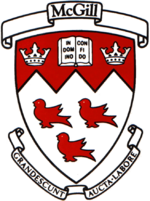
McGill's coat of arms comes from James McGill, who founded the university. It was designed in 1906. The coat of arms has a shield and a scroll. The shield shows three small birds called martlets. The university's official color is red.
The university's symbol is the martlet. This mythical bird is on the official coat of arms. McGill's motto is Grandescunt Aucta Labore. This is Latin for "By work, all things increase and grow." The official school song is "Hail, Alma Mater."
Student Exchange Programs
McGill has connections with over 160 universities around the world. Students can study abroad at these universities for one or two semesters. Each year, McGill welcomes about 500 exchange students from over 32 countries. The university offers many activities to help these students feel at home. More than 10,000 international students attend McGill. They make up over 27 percent of all students.
University Finances
McGill's money from gifts, called an endowment, helps pay for about 10 percent of its yearly costs. McGill's endowment is one of the largest among Canadian universities. As of 2022, it was worth over $2 billion.
In 2007, McGill started a fundraising campaign called Campaign McGill. The goal was to raise over $750 million. This money was to attract top talent and improve education. The campaign ended in 2013, having raised over $1 billion. In 2019, McGill started a new fundraising campaign called Made By McGill, aiming for $2 billion.
In 2019, McGill received a $200 million gift. This money was to create the McCall MacBain Scholarships program. This was the largest single gift to a Canadian university at that time.
Academics at McGill
How to Get Admitted
McGill University accepts about 38 percent of all students who apply. About 22 percent of all students are in the Faculty of Arts. This is McGill's largest academic group. Other large groups include the Faculty of Science and the Faculty of Medicine.
Undergraduate Admissions
McGill students from high school and CEGEP have very high grades. For students from outside Quebec, the average grade 12 scores were between 93.2 percent and 94.4 percent. For American students, the average SAT scores were high.
Law School Admissions
McGill's law school is bilingual, meaning it uses both English and French. Because of this, applicants do not need to take the LSAT. For students who did submit LSAT scores, the average score was 163.
Medical School Admissions
For medical students starting in 2024, the average GPA was 3.89 out of 4.0. McGill does not require Canadian university graduates to take the MCAT.
MBA Program Admissions
For the MBA program, students had an average GMAT score of 670. They also had an average of five years of work experience. Most MBA students are bilingual, speaking two languages. Many are trilingual, speaking three languages.
Teaching and Learning at McGill
In the 2007–2008 school year, McGill offered over 340 programs. It also had over 250 master's and doctoral degree programs. McGill has about 16 students for every teacher. There are nearly 1,600 full-time professors teaching at the university.
Tuition fees change based on what students study and where they are from. For example, Quebec students pay less than Canadian students from other provinces. International students pay more.
McGill has a scholarship program called Project Hero. It helps families of Canadian military members who have died. McGill also gives out Schulich Leader Scholarships. These are large scholarships for students in science, technology, engineering, and math.
Language Policy
McGill is one of three English-speaking universities in Quebec. You do not need to speak French to attend. However, the Faculty of Law requires students to understand both English and French. This is because classes can be taught in either language. Most students at McGill speak at least two languages. In 2021, about 72 percent of McGill students said they could speak French at an "intermediate" level or better.
Even though classes are in English, students can write their papers in French. This has been allowed since 1964.
In 1969, some people wanted McGill to become a French-speaking university. This movement was called McGill français. They felt that English was too powerful in business. They thought McGill, with mostly English-speaking students, helped English speakers control the economy. However, most students and teachers at McGill did not agree with this idea.
University Rankings and Reputation
| University rankings | |
|---|---|
| Global rankings | |
| ARWU World | 74 |
| QS World | 27 |
| Times World | 45 |
| Times Employability | 29 |
| U.S News & World Report Global | 56 (tie) |
| Canadian rankings | |
| ARWU National | 3 |
| QS National | 1 |
| Times National | 3 |
| U.S News & World Report National | 3 |
| Maclean's Medical/Doctoral | 1 |
McGill is ranked first in Canada among medical-doctoral universities by Maclean's in 2025. It has been in the top spot for 20 years. The Globe and Mail said McGill is "above average" for student help and research.
Around the world, McGill is ranked 27th by the 2026 QS World University Rankings. It is also ranked 45th by the 2025 Times Higher Education World University Rankings. In 2024, the Academic Ranking of World Universities placed McGill 74th globally.
In 2022, McGill was ranked 29th in the world for how well its graduates find jobs. This was by Times Higher Education.
McGill's MBA program is also highly ranked. Quacquarelli Symonds ranked it 59th in the world in 2021.
McGill is part of the Global University Leaders Forum (GULF). This group includes leaders from 29 top universities worldwide. McGill is the only Canadian university in GULF. It is also one of only two non-American universities in the Association of American Universities. This group is for universities that do a lot of research.
Research at McGill
McGill is linked to 12 Nobel Laureates. Its professors have won important teaching awards. McGill researchers work with about 75 major research centers. They also partner with other universities and businesses. In 2016, McGill received over $547 million for research. This was the second highest in Canada.
McGill is a founding member of Universitas 21. This is a group of leading research universities from around the world. McGill is also a member of the U15. This is a group of important research universities in Canada.
McGill-Queen's University Press started in 1963. It publishes books about Canadian studies.

Many important discoveries in medicine and neuroscience happened at McGill. These include work by William Osler and Wilder Penfield. The first hormone for the immune system was found at McGill in 1965.
The world's first artificial cell was invented by Thomas Chang. He was a student at McGill at the time. While at McGill, physicist Ernest Rutherford discovered the alpha particle. This led to him winning the Nobel Prize in Chemistry in 1908.
Libraries, Archives, and Museums
The McGill University Library has 12 branches. It holds over 11.5 million items. The Department of Rare Books & Special Collections has about 350,000 rare items. The Islamic Studies Library has over 125,000 books about Islamic civilization. The Osler Library of the History of Medicine is the largest medical history library in Canada.
The McGill University Archives keeps old papers, photos, and other items. These documents tell the story of McGill University.
The Redpath Museum has collections about people, animals, old bones, and rocks. It was built in 1882. It is the oldest building in Canada made just to be a museum.
The McGill Medical Museum collects and shows items about medicine at McGill. It has old medical tools and wax models. It also has many preserved body parts that show diseases.
Student Life at McGill
Student Population
As of Fall 2021, McGill has over 26,000 undergraduate students and over 10,000 graduate students. Students come from many different places. About 46.8 percent are from Quebec. About 22.8 percent are from other parts of Canada. And 30.4 percent are from outside Canada. International students come from about 150 countries. Many are from the United States, China, and France.
Over half of McGill students speak a first language other than English. About 19.7 percent speak French as their first language.
Student Groups
Students at McGill have active student groups. The main one for undergraduate students is the Students' Society of McGill University (SSMU). There is also a group for graduate students.
SSMU supports more than 250 student clubs. These clubs cover many interests. They include sports, arts, and professional development groups. SSMU also offers 17 student-run services. These services help all students. Examples include the Flat Bike Collective and Queer McGill.
Many student clubs meet in the University Centre. In 1992, students wanted to rename this building after actor and McGill graduate William Shatner. The university did not officially change the name. But students still often call it the Shatner Building.
Student News and Media
McGill has several student-run newspapers. The McGill Daily used to be printed twice a week. Now it is printed once a week. Le Délit français is the French version of the Daily. The McGill Tribune is printed once a week. CKUT (90.3 FM) is the campus radio station. TVMcGill is the university's TV station.
The McGill University Faculty of Law has three student-run academic journals. One is the McGill Law Journal, started in 1952.
Fraternities and Sororities
McGill has several fraternities and sororities. These are social groups for students. Canada's only national fraternity, Phi Kappa Pi, was started at McGill in 1913. McGill was also the first university outside the United States for some Greek letter organizations. About 2 percent of McGill students are in fraternities and sororities.
Sports at McGill
McGill's sports teams are called the McGill Redbirds and Martlets. The Redbirds are for men's teams, and the Martlets are for women's teams. McGill has 28 varsity teams. They are known for their strong baseball, hockey, and lacrosse programs. McGill's mascot is Marty the Martlet. He was introduced in 2005.
The downtown campus has many sports facilities. These include the McGill Sports Centre and Molson Stadium. The Macdonald Campus also has an arena, a gym, and a pool. Molson Stadium was built in 1914. After being expanded in 2010, it can now hold over 25,000 people. It is the home field for the Montreal Alouettes football team.
Notable People from McGill
Many McGill alumni have helped start other universities. These include the first President of the University of British Columbia and the co-founder of the Johns Hopkins School of Medicine.
In the arts, McGill students include four Pulitzer Prize winners. Also, Emmy Award-winning actor William Shatner went to McGill. So did Grammy Award winner and poet Leonard Cohen.
In science, McGill graduates and teachers have won 12 Nobel Prizes. McGill has also produced five astronauts. Other famous science alumni include the inventor of the artificial cell Thomas Chang.
In law and politics, McGill alumni include three Prime Ministers of Canada: John Abbott, Wilfrid Laurier, and Justin Trudeau. Also, one Governor General of Canada, Julie Payette, went to McGill. John Peters Humphrey helped write the Universal Declaration of Human Rights.
In sports, McGill students and alumni have won 35 Olympic medals. The inventor of basketball, James Naismith, also went to McGill.
- Notable McGill alumni include:
-
3rd prime minister of Canada Sir John Abbott (BCL, 1847).
-
7th prime minister of Canada Sir Wilfrid Laurier (BCL, 1864).
-
Inventor of the game of basketball James Naismith (BA, 1887).
-
First woman elected to the Quebec National Assembly Marie-Claire Kirkland (BA 1947, BCL 1950).
-
Co-inventor of the CCD and Nobel prize laureate in Physics Willard Boyle (BSc, 1947; MSc 1948; PhD 1950).
-
Emmy Award winner known for his portrayal of Captain Kirk in the Star Trek franchise William Shatner (BComm, 1952).
-
Balzan Prize winner, referred to as "the founder of neuropsychology" Brenda Milner (PhD, 1952)
-
Grammy Award winner and poet Leonard Cohen (BA, 1955).
-
6th President of Latvia Vaira Vīķe-Freiberga (PhD, 1965).
-
48th Prime Minister of Egypt Ahmed Nazif (PhD, 1983).
-
Former astronaut and 29th governor general of Canada Julie Payette (BEng, 1986).
-
Turing Award winner Yoshua Bengio (BEng, 1986; MSc, 1988; PhD, 1991).
-
The 23rd prime minister of Canada Justin Trudeau (BA, 1994).
-
Former international president of Médecins Sans Frontières Joanne Liu (MDCM, 1991; IMHL, 2014).
See also
 In Spanish: Universidad McGill para niños
In Spanish: Universidad McGill para niños
- List of McGill University people
- McGill University School of Architecture
- Schulich School of Music
- Academic dress of McGill University
- Canadian government scientific research organizations
- Canadian industrial research and development organizations
- Canadian university scientific research organizations
- Cundill History Prize, awarded by McGill
- History Trek, developed by McGill researchers
- List of Canadian universities by endowment
- List of oldest universities in continuous operation
- Maude Abbott Medical Museum
- McGill University Non-Academic Certified Association
- McGill University School of Information Studies
- Montreal Laboratory (for nuclear research, World War II)
- Osler Library of the History of Medicine
- McGill University Department of Social Studies of Medicine
- U15 Group of Canadian Research Universities
- Montreal experiments


